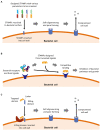Targeted Antimicrobial Agents as Potential Tools for Modulating the Gut Microbiome
- PMID: 35875544
- PMCID: PMC9302920
- DOI: 10.3389/fmicb.2022.879207
Targeted Antimicrobial Agents as Potential Tools for Modulating the Gut Microbiome
Abstract
The gut microbiome plays a pivotal role in maintaining the health of the hosts; however, there is accumulating evidence that certain bacteria in the host, termed pathobionts, play roles in the progression of diseases. Although antibiotics can be used to eradicate unwanted bacteria, the side effects of antibiotic treatment lead to a great need for more targeted antimicrobial agents as tools to modulate the microbiome more precisely. Herein, we reviewed narrow-spectrum antibiotics naturally made by plants and microorganisms, followed by more targeted antibiotic agents including synthetic peptides, phage, and targeted drug delivery systems, from the perspective of using them as potential tools for modulating the gut microbiome for favorable effects on the health of the host. Given the emerging discoveries on pathobionts and the increasing knowledge on targeted antimicrobial agents reviewed in this article, we anticipate targeted antimicrobial agents will emerge as a new generation of a drug to treat microbiome-involved diseases.
Keywords: antimicrobial peptides; bacteriocins; berberine; microbiome editing; pathobionts; phage therapy; polyphenols; targeted drug delivery system.
Copyright © 2022 Chou, Zhang, Guo, Chang, Zhao and Mou.
Conflict of interest statement
The authors declare that the research was conducted in the absence of any commercial or financial relationships that could be construed as a potential conflict of interest.
Figures


Similar articles
-
Microbiome-phage interactions in inflammatory bowel disease.Clin Microbiol Infect. 2023 Jun;29(6):682-688. doi: 10.1016/j.cmi.2022.08.027. Epub 2022 Oct 1. Clin Microbiol Infect. 2023. PMID: 36191844 Review.
-
Bacteriocins and bacteriophage; a narrow-minded approach to food and gut microbiology.FEMS Microbiol Rev. 2017 Aug 1;41(Supp_1):S129-S153. doi: 10.1093/femsre/fux022. FEMS Microbiol Rev. 2017. PMID: 28830091 Review.
-
Immunization with a Biofilm-Disrupting Nontypeable Haemophilus influenzae Vaccine Antigen Did Not Alter the Gut Microbiome in Chinchillas, Unlike Oral Delivery of a Broad-Spectrum Antibiotic Commonly Used for Otitis Media.mSphere. 2020 Apr 15;5(2):e00296-20. doi: 10.1128/mSphere.00296-20. mSphere. 2020. PMID: 32295873 Free PMC article.
-
Alternatives to antibiotics: bacteriocins, antimicrobial peptides and bacteriophages.Poult Sci. 2003 Apr;82(4):640-7. doi: 10.1093/ps/82.4.640. Poult Sci. 2003. PMID: 12710486 Review.
-
Food and gut originated bacteriocins involved in gut microbe-host interactions.Crit Rev Microbiol. 2023 Aug;49(4):515-527. doi: 10.1080/1040841X.2022.2082860. Epub 2022 Jun 17. Crit Rev Microbiol. 2023. PMID: 35713699 Review.
Cited by
-
Compartmentalization of the host microbiome: how tumor microbiota shapes checkpoint immunotherapy outcome and offers therapeutic prospects.J Immunother Cancer. 2022 Nov;10(11):e005401. doi: 10.1136/jitc-2022-005401. J Immunother Cancer. 2022. PMID: 36343977 Free PMC article. Review.
-
Key Insights into Gut Alterations in Metabolic Syndrome.J Clin Med. 2025 Apr 14;14(8):2678. doi: 10.3390/jcm14082678. J Clin Med. 2025. PMID: 40283508 Free PMC article. Review.
-
Heterologously expressed SacP23, a novel bacteriocin from Paenibacillus polymyxa #23, is active against methicillin resistant Staphylococcus aureus.R Soc Open Sci. 2023 Dec 20;10(12):231119. doi: 10.1098/rsos.231119. eCollection 2023 Dec. R Soc Open Sci. 2023. PMID: 38126065 Free PMC article.
-
Infection and the microbiome in bronchiectasis.Eur Respir Rev. 2024 Jul 3;33(173):240038. doi: 10.1183/16000617.0038-2024. Print 2024 Jul. Eur Respir Rev. 2024. PMID: 38960615 Free PMC article. Review.
-
Berberine a traditional Chinese drug repurposing: Its actions in inflammation-associated ulcerative colitis and cancer therapy.Front Immunol. 2022 Dec 6;13:1083788. doi: 10.3389/fimmu.2022.1083788. eCollection 2022. Front Immunol. 2022. PMID: 36561763 Free PMC article. Review.
References
-
- Adrián Calderon J. S., Dapello G., Gamboa E., Rosas J., Chávez J., Retuerto F., et al. . (2019). Assessment of antibacterial and antifungal properties and In vivo cytotoxicity of Peruvian Passiflora mollisima. J. Contemp. Dent. Pract. 20, 145–151. doi: 10.5005/jp-journals-10024-2489, PMID: - DOI - PubMed
Publication types
LinkOut - more resources
Full Text Sources

